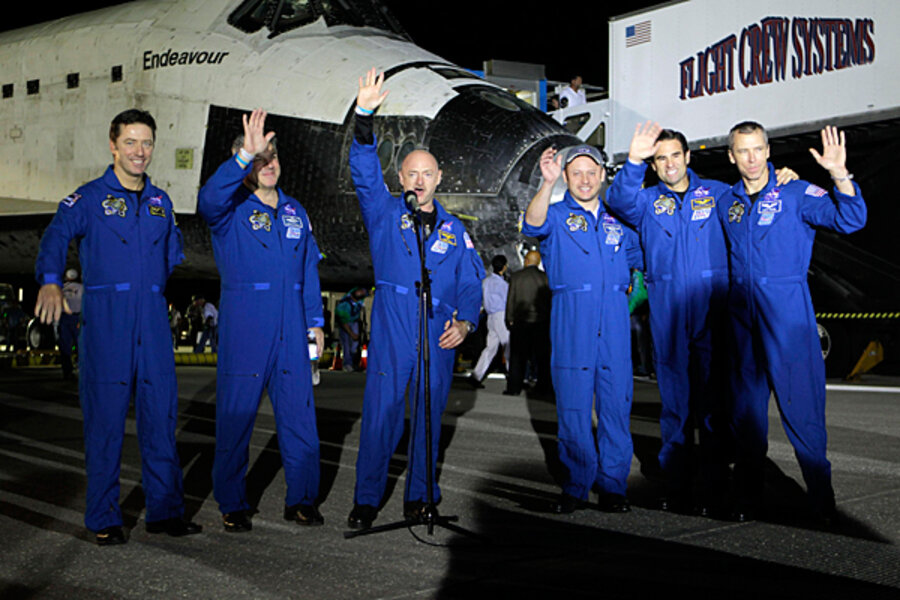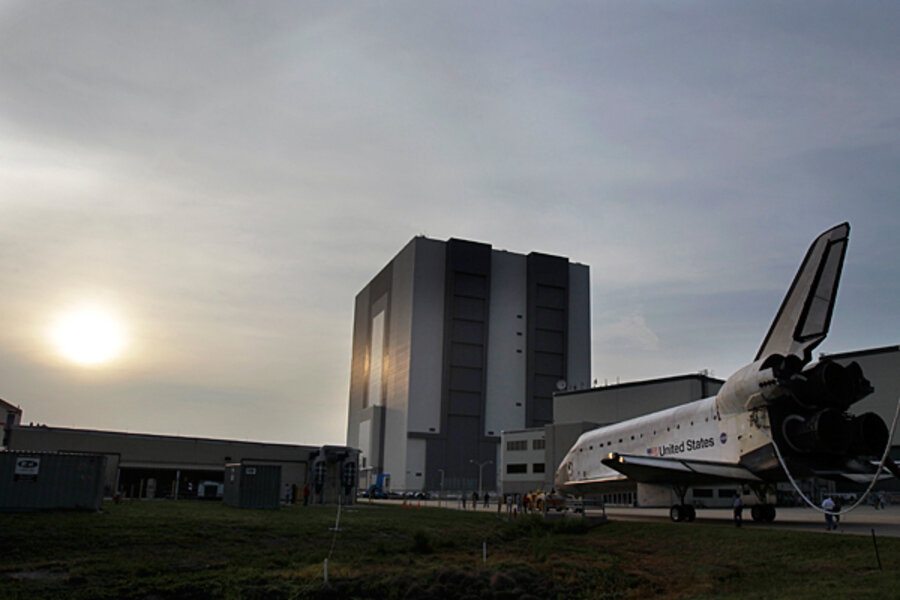Space shuttle Endeavour on terra firma, ending 19 years as orbiter
Loading...
The space shuttle Endeavour and its six-member crew glided to a flawless predawn landing at the Kennedy Space Center Wednesday morning – capping a 16-day mission as well as Endeavour's 19-year career as an orbiting space plane.
During the mission, the crew traveled to the International Space Station and installed a $2 billion particle physics experiment, delivered a pallet piled with spare parts, and performed a range of maintenance tasks aimed at preparing the station for life after shuttles.
With its career over, Endeavour will be decommissioned and shipped to the California Science Center in Los Angeles for display. The spot where its nose wheel stopped will be marked by a commemorative plaque on the side of the shuttle runway.
As if to pass the baton to the shuttle Atlantis, which is being prepared for the shuttle program's final launch no earlier than July 8, Endeavour touched down at about the time technicians finished rolling Atlantis out to launch pad 39A and secured it to its supports there.
With both operations going on simultaneously, "it's been a heck of a month in the last four hours," quipped Michael Moses, the shuttle program's launch integration manager, during a briefing after Endeavour's return.
The mission's centerpiece was the installation of the Alpha Magnetic Spectrometer (AMS), a 7.4-ton particle detector put together by an international collaboration headed by physicist Samuel Ting, a Nobel laureate at the Massachusetts Institute of Technology in Cambridge.
Within three or four hours of its installation, the detector began returning data that the science team – researchers from some 60 institutions in 16 countries – will pore over for evidence of dark matter, estimated to comprise 83 percent of all the matter in the universe.
Researchers also are looking for signatures in the detector that can help solve a longstanding puzzle over why the universe appears to have so little antimatter, when matter and antimatter should have been created in equal amounts as the universe emerged from the big bang – the sudden release of pent-up energy that cosmologists say spawned the cosmos.
And the detector will provide the most detailed look yet at the full spectrum of cosmic rays – essentially the nuclei of atoms – that astronauts would face as NASA prepares to explore destinations beyond low-Earth orbit.
Like a major department store that "anchors" a shopping mall, the AMS has become the high-profile tenant on the space station, marking the outpost's transition from "under construction" to "open for business" as a long-term, national-laboratory-class research facility.
"There were times when we weren't sure it [AMS] was going to fly" as NASA scaled back its plans for the shuttles after the Columbia disaster in 2003, says William Gerstenmaier, NASA's associate administrator for space operations.
Now, "to see it there and actually taking data is special," he says.
The mission included the shuttle program's last four spacewalks – one an eight-hour marathon on May 22 that included performing a lube job on two large joints that rotate the station's solar panels. That task included an unexpected game of "grab that bolt." Five bolts from a joint's thermal cover came loose unexpectedly and began to drift away. Mission specialists Mike Fincke and Andrew Feustel manged to snag four of the would-be float-aways.
The fifth "went to heaven," Fincke told controllers at the time.
Indeed, this was a record-setting mission for Finke, who now has logged more time in space than any other US astronaut.
He spent two tours in the International Space Station, traveling to and from each time on a Russian Soyuz.
For him, this final trip on the shuttle was a childhood dream come true.
"I was an 8- or 9-year-old kid that wanted to fly on this new space-shuttle thing. It wasn't even built yet," he recalled during a post-flight press conference. "I was hoping, and planning, and made a T-shirt with a space shuttle on it with markers because they weren't out in the stores yet."
"I still have that T-shirt," he says.
Endeavour's return also may mark the beginning of a more peaceful period for mission commander Mark Kelly and his wife, Rep. Gabrielle Giffords (D) of Arizona, who was shot and gravely injured during a meet-and-greet with constituents in Tucson in January. Her remarkable recovery and his decision to continue as the mission's commander have added an element of human drama to the mission rarely seen while a crew is still on the ground.
Next, and last, up: Atlantis, which will carry four crew members to the space station on a 12-day mission to give the outpost one last infusion of supplies before US resupply flights are handed over to a pair of commercial launch providers – Orbital Sciences Corp. and Space Exploration Technologies (SpaceX).
Last June, SpaceX successfully launched, orbited, and retrieved a capsule atop its Falcon 9 rocket – a combo the company plans to use to ferry supplies to the space station. That launch was the first of three demonstration flights NASA required under an agreement with the Hawthorne, Calif., company. The final two demo efforts could well be folded into one mission, culminating in the company's Dragon capsule docking with the station, Mr. Gerstenmaier says. If the two remaining demonstration launches are combined, the resulting mission is likely to launch from the Kennedy Space Center in October or November, he adds.
Orbital Sciences is expected to launch its first capsule to the station in December.
The final two shuttle missions were approved in no small part as hedges against the possibility that one or both of these companies might trip along the way, delaying their first resupply runs.
When Atlantis wraps up its flight, it will return two balky space-station components – an ammonia-coolant pump and a heat exchanger – so engineers can figure out why they failed.






